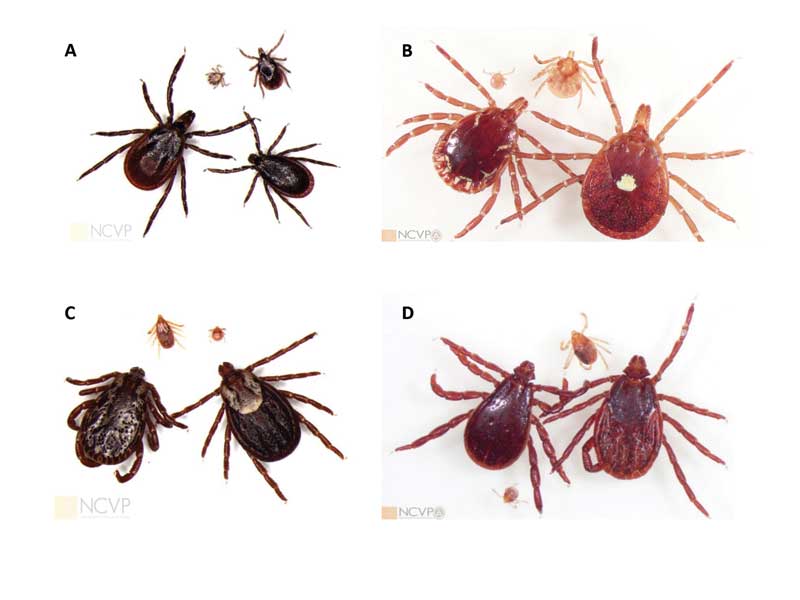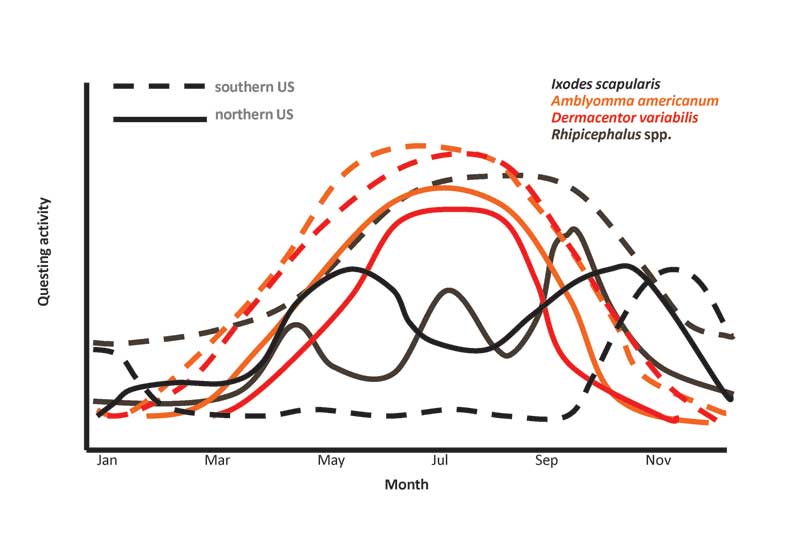
Tick populations respond enthusiastically to environmental cues, such as seasonal changes, shifting temperature, and increased precipitation, leading many pet owners and veterinary team members to conclude tick risk is primarily a seasonal concern. In actuality, although the species, stages, and number of questing ticks vary throughout the year, these ectoparasites are active every month in most populated areas of North America, creating an ongoing risk of pet infestation and infection, and tick populations have exploded in number in recent years.
This article reiterates why pets need year-round protection from ticks–now more than ever–and will cover various risks. They range from brown dog ticks that establish infestation indoors, to wildlife ticks that have dramatically expanded both geographically and seasonally in response to ongoing changes in climate, habitat, and reservoir host populations.
Every month is tick month; consistent year-round tick control is the best way to combat the growing risk.
So many ticks…
A diverse array of tick species, each transmitting a complex of different pathogens, contribute to infestation and infection risk for pets. Widespread tick species commonly found on pets in North America include deer ticks or black-legged ticks (Ixodes scapularis, I. pacificus), lone star ticks (Amblyomma americanum), American dog ticks or wood ticks (Dermacentor variabilis, D. andersoni), and brown dog ticks (Rhipicephalus spp.) (Figure 1). Additional ticks are reported from some regions, including Gulf Coast ticks (Amblyomma maculatum), the range of which has expanded to encompass a large swath of the southern and eastern U.S., and longhorned ticks (Haemaphysalis longicornis) which were apparently introduced into the U.S. in the last decade and are now established in at least 19 states.1–3

All of these common species are three-host ticks, with larval, nymphal, and adult stages feeding on different animals, and almost all species and stages have been reported from dogs and cats, creating vast opportunities for infestation and subsequent transmission of pathogens.4–6 Indeed, when adjusted for veterinary visits, cats are as likely as dogs to present with ticks and develop several tick-borne infections, some of which—such as cytauxzoonosis—are potentially fatal.4,5,7 The six-legged larvae and eight-legged nymphs are much smaller than the adult stages, but what immature ticks lack in size they more than make up for in sheer number, with pets often found infested with scores or hundreds of tiny “seed” ticks.5,8
…on so many hosts…
Most of the tick species infesting pets are sustained on wildlife hosts, making contact with natural environments a key risk factor for infestation. Adult ticks of several species—including those in the genera Amblyomma spp., Dermacentor spp., and Ixodes spp.—feed preferentially on white-tailed deer, and other large and medium sized mammals. Immature stages of A. americanum also prefer deer, although they will readily feed on a wide variety of hosts, including ground-nesting birds, such as a wild turkey.9 Immature I. scapularis and D. variabilis prefer small mammals, such as rodents; in the southern U.S., immature I. scapularis often feed on lizards and skinks.3
Ticks can also be introduced into the home on clothing or the haircoat of untreated pets, putting even indoor-only pets at risk of infestation.4,5 Brown dog ticks (Rhipicephalus spp.) are a key exception to the natural rule and are maintained almost entirely on the domestic dogs for which they show a pronounced host preference. Accordingly, Rhipicephalus spp. are found in homes and kennels, wherever there are dogs.3
An ever-changing world
In recent decades, anthropogenic changes including reforestation and afforestation, increase in wildlife populations, and climate change have conspired to support increased tick numbers in areas where ticks have long been present, as well as allow ticks to expand into new geographic locations. Habitat change and increase in wildlife reservoir hosts often occurs in concert. For example, invasive honeysuckle has been shown to result in higher populations of lone star ticks and more cases of ehrlichiosis by providing increased browse for deer.10 In areas where I. scapularis transmits the agent of Lyme disease, increased acorn production from oak trees results in healthier rodent populations and subsequent higher tick populations.11
In addition, as winter temperatures continue to rise, several common species of ticks have expanded their seasonal activity. Ticks such as A. americanum and D. variabilis, which were previously considered to be largely spring and summer pests, are now also found seeking hosts during the winter months.12 Cool-weather adapted ticks, including adult I. scapularis, which become active whenever temperatures are above 38–40°F, can now be found questing for hosts intermittently throughout the winter months.
Review of ticks collected from dogs and cats throughout the year shows pets are infested every month of the year.4,5 Although seasonal trends in intensity of infestation persist (Figure 2), the changed habitat and climate in North America has resulted in a new normal of year-round activity of wildlife ticks.

While not commonly sustained in natural habitats or on wildlife in North America, brown dog ticks (Rhipicephalus spp.) have also thrived in this region in recent years. All life stages (larvae, nymphs, and adults) of canine Rhipicephalus spp. have a strong host preference for dogs. Because brown dog ticks are also endophilic, or able to survive long-term indoors in homes and kennels, premise infestations readily develop.3,11 Although long considered a single species referred to as “R. sanguineus,” recent work has confirmed at least three canine Rhipicephalus spp. may be found in the U.S. and Canada, including R. sanguineus sensu stricto (temperate lineage), R. linnaei (tropical lineage), and R. rutilus (southeastern European lineage).13,14 These different ticks are not able to interbreed and produce offspring, although occasionally dogs are found infested with multiple lineages.13
Brown dog ticks are much more common in warmer geographic regions, with R. linnaei most common in southern Florida, south Texas, and southern Arizona; and R. sanguineus sensu stricto more prevalent in the middle south, in a band extending from North and South Carolina across to Arkansas and Oklahoma.13 However, translocation of dogs through pet travel and dog rescue and rehoming efforts can result in introduction and establishment of canine Rhipicephalus spp. premise infestations anywhere there are dogs.14
Because brown dog ticks persist in indoor, climate-controlled environments, infestations are found every month of the year.13
Tick control is now more important than ever
In response to the growing health challenges presented by ticks, the Companion Animal Parasite Council (CAPC) recommends all pets be maintained on tick control year-round.15 Similarly, the American Animal Hospital Association (AAHA) recommends routine tick control for dogs, and the joint AAHA/American Association of Feline Practitioners (AAFP) guidelines recognize the increasing importance of preventing ticks on cats.16,17 Routine use of either repellent or systemic acaricides protects pets from persistent infestations and has been shown to reduce transmission of several tick-borne infections.16
Flea and tick control should be administered together with heartworm and intestinal parasite prevention each month. Several effective pet insecticidal/acaricidal products are now available in combination with compounds to control other parasites, including heartworm and intestinal helminths, making comprehensive control against ticks and other parasites easier than ever.
At times of the year, when tick populations are particularly intense and risk of infestation is high, systemic products can be combined with topical spot-on compounds or acaricidal collars to offer another layer of protection. Regardless of the strategy employed, given the ongoing and ever-increasing threat posed by ticks, broad-spectrum tick prevention must be included in the overall parasite control plan for pets.
Susan Little, DVM, PhD, DACVM (Parasitology), is a veterinary parasitology educator, researcher, and scholar with particular expertise in zoonotic agents, arthropods, and vector-borne diseases. Dr. Little has authored more than 150 publications in veterinary parasitology research, founded and serves on the advisory board of the National Center for Veterinary Parasitology, is a past-president of the American Association of Veterinary Parasitologists (AAVP), and an Emeritus Member and past-president of the Companion Animal Parasite Council (CAPC). In 2017, the AAVP named her Distinguished Veterinary Parasitologist.
References
- Sonenshine DE. Range expansion of tick disease vectors in North America: implications for spread of tick-borne disease. Int J Environ Res Public Health. 2018;15:478.
- Beard CB, Occi J, Bonilla DL, et al. Multistate Infestation with the exotic disease-vector tick Haemaphysalis longicornis. United States, August 2017-September 2018. MMWR Morb Mortal Wkly Rep. 2018;67:1310–1313.
- Saleh MN, Allen KE, Lineberry MW, et al. Ticks infesting dogs and cats in North America: Biology, geographic distribution, and pathogen transmission. Vet Parasitol. 2021;294:109392.
- Little SE, Barrett AW, Nagamori Y, et al. Ticks from cats in the United States: Patterns of infestation and infection with pathogens. Vet Parasitol. 2018;257:15–20.
- Saleh MN, Sundstrom KD, Duncan KT, et al. Show us your ticks: a survey of ticks infesting dogs and cats across the USA. Parasit Vectors. 2019;12:595.
- DeWinter S, Bauman C, Peregine A, et al. Infestation patterns of Ixodes scapularis and Dermacentor variabilis on dogs and cats across Canada. PLoS One. 2023;18:e0281192.
- Nagamori Y, Reichard M. Parasitology Expertise from the NCVP: Feline Tick-Borne Diseases. Today’s Vet Pract. 2015;May/June.
- Thomas JE, Reichard MV. Ticks, Chapter 109. In: Greene’s Infectious Diseases of the Dog and Cat, 5th Edition. Ed JE Sykes. 2023. Elsevier, St Louis. Pp 1359-1377.
- McClung KL, Little SE. Amblyomma americanum (lone star tick). Trends Parasitol. 2023;39:70–71.
- Allan BF, Dutra HP, Goessling LS, et al. Invasive honeysuckle eradication reduces tick-borne disease risk by altering host dynamics. Proc Natl Acad Sci USA. 2010;107:18523–7.
- Ostfeld RS, Levi T, Keesing F, et al. Tick-borne disease risk in a forest food web. Ecology. 2018;99:1562–1573.
- Raghavan RK, Koestel ZL, Boorgula G, et al. Unexpected winter questing activity of ticks in the Central Midwestern United States. PLoS One. 2021;16:e0259769.
- Grant AN, Lineberry MW, Sundstrom KD, et al. Geographic Distribution and Seasonality of Brown Dog Tick Lineages in the United States. J Med Entomol. 2023;60:102–111.
- Myers S, Clow K, DeWinter S, et al. Multiple species of canine Rhipicephalus complex detected in Canada. Vet Parasitol Reg Stud Rep. 2023:100976.
- Companion Animal Parasite Council (CAPC). Ticks. https://capcvet.org/guidelines/ticks/ Accessed December 4, 2023.
- Creevy KE, Grady J, Little SE, et al. 2019 AAHA Canine Life Stage Guidelines. J Am Anim Hosp Assoc. 2019;55:267–290.
- Quimby J, Gowland S, Carney HC, et al. 2021 AAHA/AAFP Feline Life Stage Guidelines. J Am Anim Hosp Assoc 2021;57:51–72.
